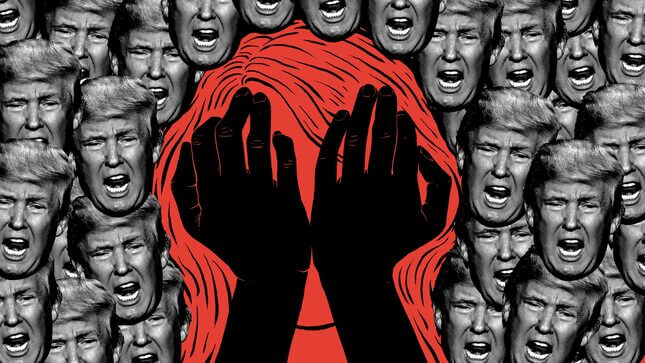Chaos Weary
Latest
About a year ago, in early 2017, I briefly joined a stress-management program that functioned sort of like a support group. I was feeling brittle and panicked; alongside millions of other Americans, the generalized anxiety that normally keeps me company had grown exponentially in the aftermath of the 2016 election.
The program requires regular “check-ins” with yourself or other members of the group to determine your stress level—from one (very relaxed) to five (very stressed)—and gives you “tools” to manage each level. If you’re at a three, for example, you begin with an expression of rage. “I AM ANGRY THAT…” you’re meant to yell, describing why you feel angry, even if you don’t particularly feel angry. If all goes according to plan, anger should eventually collapse into sadness. “I am sad that…” you say quietly. Then you’re afraid. This was always easy, if embarrassingly self-centered. I’m afraid of dying alone. I’m afraid I have an extremely early-onset case of Alzheimer’s that is so rare it will remain undiagnosed until I wander into the street in my underwear and get hit by a bus. And then you are “grateful for…”, “happy that…”, “secure that…”, “proud that…”
The idea is to methodically acknowledge your layers of feeling, and to cycle through your anxiety in a way that allows you to climb out of it. Though I found it effective, it can be a frustrating exercise. How does a person in a state of passive dejection generate fury? How do you mime security when you’re much more accustomed to dread?
since the first days of the Trump administration, everything and nothing about the Trump White House has changed.
Though I eventually dropped out, I think about this program every once in a while as the powerful feelings I’d experienced directly following the election become increasingly and somewhat mysteriously inaccessible to me. How are we (“we” meaning those of us who are not at peace with or indifferent to Trump’s policies and behavior, and those of us who are not living underneath a more immediate and palpable threat of forced detention and deportation; “we” meaning those of us in the position to be sitting around pondering this question in the first place) processing the impossibly long-term and unprecedentedly visible insanities of the Trump era? It’s one thing to push yourself into various emotional experiences based on intimate daily anxieties. It’s another thing altogether to remain indefinitely grounded in the terror of a democratic meltdown; to “maintain one’s capacity for shock,” as Masha Gessen’s now-canonic essay on autocracy instructs us.
In the year since I wrote about the chaos of the first days of the Trump administration, everything and nothing about the Trump White House has changed. It’s as ludicrous, corrupt, and malicious today as it was when Sean Spicer berated reporters about the allegedly massive size of Trump’s inauguration crowd last January. But the way the Trump administration’s captive audience relates to this chaos has changed; it had to, because it has invaded every nook and cranny of our lives. As nonstop political turbulence intersects with our relatively newfound ability to watch it unfold in real time, we must be, in some slippery but fundamental way, different than we were. It’s a disconcerting process, watching yourself get used to something terrible.
It was around the time of Spicer’s big, false brag about the inauguration crowd that Jezebel’s The Slot launched a nightly feature called “Barf Bag.” At the time, the onslaught of outrageous breaking news was still relatively new, and absent a comprehensive way to cover it all, we decided just to shove all the extra political news down everyone’s throats at the end of each day. It seemed like a decent idea at the time.
“[Trump has] spent his life creating and surrounding himself with chaos so that he can be the one person who can emerge in charge. The winner.”
Barf Bag quickly morphed into a crushing daily reminder of the impossible vastness of the changes afoot; I can count the days on one hand when we’ve had to scrape around for items to fill this blog. Today’s version of a “slow news day” would be unrecognizable two years ago, what with the gleeful degradation of environmental regulations and protections, the parade of comically unqualified judicial nominees, the endless foreign policy disasters, the investigations, the hearings, the resignations, the palace intrigue, the nuclear threats, the racist rhetoric, the steady violent rush of deportations.
The story of this presidency can be distilled into a cluster of cartoonish declarations and images—“shithole” and “I’m not trying to suck my own cock” immediately spring to mind; as does the president pretending to drive a big truck, the president shoving the Prime Minister of Montenegro, the president’s teeth appearing to fall out of his mouth mid-speech, and Ted Nugent posing happily for photographs in the Oval Office. You’d think that our newfound capacity to see everything that’s happening would turn us all into super-citizens, but increasingly, it feels like we are driven to process these more absurd items as entertainment—a result, maybe, of what’s become known as “outrage fatigue,” meaning, according to Yale psychology professor Molly Crockett, that “constant exposure to outrageous news could diminish the overall intensity of outrage experiences.”
“[Trump has] spent his life creating and surrounding himself with chaos,” former Trump Organization vice president Barbara Res told Politico in July, “so that he can be the one person who can emerge in charge. The winner. The guy on the top. It’s a way of slaying his enemies.” The enemies, in Trump’s case, appear to be the American people.
-

-

-

-

-

-

-

-

-

-

-

-

-

-

-

-

-

-

-

-

-

-

-

-

-

-

-

-

-

-

-

-

-

-

-

-

-

-

-

-








































